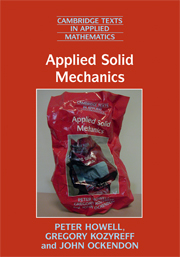Book contents
Asymptotic analysis
Published online by Cambridge University Press: 02 February 2010
Summary
Introduction
In Chapter 4, we derived various approximate models for thin or slender elastic configurations such as rods and plates. These models were obtained using net force and moment balances combined with ad hoc constitutive relations, for example between the bending moments and the curvatures. In this chapter, we show how such models may be derived systematically from the underlying continuum equations and boundary conditions. We concentrate on a few canonical models for plates, beams, rods and shells. Each of these models is important in its own right, and their derivation illustrates the tools that are widely useful for analysing more general thin structures.
The basic idea is to exploit the slenderness of the geometry so as to simplify the equations of elasticity asymptotically. This process is made systematic by first non-dimensionalising the equations, so that all the variables are dimensionless and of order one. This highlights the small slenderness parameter ε = h/L, where h is a typical thickness and L a typical length of the elastic body. A simplified system of equations is then obtained by carefully taking the limit ε → 0. Typically, the solution is sought as an asymptotic expansion in powers of the small parameter ε, and the techniques demonstrated here fall within the general theories of asymptotic expansions and perturbation methods. Kevorkian & Cole (1981), Hinch (1991) and Bender & Orszag (1978) provide very good general expositions of these methods.
- Type
- Chapter
- Information
- Applied Solid Mechanics , pp. 245 - 286Publisher: Cambridge University PressPrint publication year: 2008

